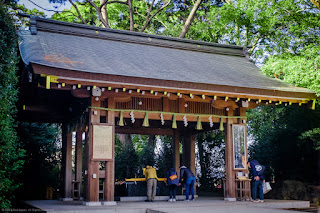Pentax K-1 II + DFA 28-105mm F3.5-5.6
88 mm ISO 100 for 1/160 sec. at ƒ/13
Location: Kinkanzan, Shizuoka Prefecture, Japan
Timestamp: 13:04 January 31, 2023
View from Mountain Peak
View of the cities Numazu and Shimizu located on the coast of Suruga Bay in Shizuoka Prefecture, Japan, with a clear view of Awashima Island in the center. If you visit on a clear day, Mt. Fuji can be seen to the north.
This shot was taken from the peak of Mt. Kinkan (elevation 816 m/2,677 ft) in the northeastern region of the Izu Peninsula.
The trailhead to this peak is located near the Daruyama Kogen Resthouse parking lot, which is about a 2.5-hour drive from central Tokyo.
The hike to the peak is not very difficult, but is a bit steep in some sections. There were patches of snow on the trail with several locations becoming quite muddy.
Pentax K-1 II + DFA 28-105mm F3.5-5.6
28 mm ISO 100 for 1/250 sec. at ƒ/8.0
Tiny Fishing Port on the Bay
Location: Mt. Kinkan, Shizuoka Prefecture, Japan
Timestamp: 12:58 January 31, 2023
View of Heda Port located on the eastern coast of Suruga Bay in Shizuoka Prefecture, Japan. In the far distance lies the city of Shizuoka on the opposite side across the bay.
The climb to Mt. Kinkan (elevation 816 m/2,677 ft) from the nearby parking lot took only about an hour and that was with a heavy backpack full of camera and video gear on a muddy and snowy trail.
If visiting on a warm spring day when the trail is dry, you can easily reach the peak in less than an hour. Just be sure to wear shoes that provide some traction on the soles so as to avoid slipping on rocks.
Bonus tip: Try to visit on a weekday with no crowds and be extra quiet—you might be lucky enough to catch a glimpse of some of the deer that live on these slopes. My dog and I saw two large bucks only 10 minutes from the trailhead!
Pentax K-1 II + DFA 28-105mm F3.5-5.6
105 mm ISO 100 for 1/320 sec. at ƒ/5.6
Location: Mt. Kinkan, Shizuoka Prefecture, Japan
Timestamp: 13:00 January 31, 2023
Border Collie Resting on Mountain Peak
The winds were a bit chilly at the peak of Mt. Kinkan at an elevation of 816 m (2,677 ft), located about 136 km (84.6 mi) southwest of Tokyo.
She has a tendency to run ahead on the trail while I take my time pacing myself one step at a time. Here, she is taking a well-deserved rest after reaching the peak first.
Pentax K-1 II + DFA 28-105mm F3.5-5.6
73 mm ISO 100 for 1/40 sec. at ƒ/13
Location: Mt. Daruyama, Shizuoka Prefecture, Japan
Timestamp: 14:53 January 31, 2023
Sunlit Cape and Fishing Port under Cloudy Sky
With the help of a telephoto lens, the peak of Mt. Darumayama offers a clear view of Cape Mihama, which stretches south to north creating the calm and sandy shores of Heda Port located on the eastern coast of Suruga Bay in Shizuoka Prefecture, Japan.
The trailhead to Mt. Darumayama can be easily accessed from the Asebigahara Parking Lot located about 220 meters away on the Nishi-Izu Skyline toll road.
On this photo shoot, my border collie and I hiked directly from Mt. Kinkan to Mt. Darumayama via Mt. Kodarumayama, which took me about 2 hours.
Be forewarned that the trails for Mt. Kodarumayama and Mt. Darumayama include many wooden staircases going straight up the side of the mountain. No special hiking gear is required, but be sure to bring enough water with you since you will work up a sweat climbing all those stairs!
Fujifilm X100V (23 mm) with 5% diffusion filter
ISO 2500 for 1/250 sec. at ƒ/2.0
Classic Chrome film simulation
Location: Mt. Daruma, Shizuoka Prefecture, Japan
Timestamp: 14:20 January 31, 2023
Trail to Grass-Covered Mountain Peak
The winding Nishi-Izu Skyline toll road is a popular route for both motor and cycling enthusiasts. At the second curve, you can see the Asebigahara Parking Lot and the trail to Mt. Kodaruma, which if you keep heading north, will take you to the peak of Mt. Kinkan.
This shot was taken on my way up to the peak of Mt. Daruma (approx. 982 m/3,221 ft), which is mostly covered in kuma bamboo grass (kumazasa/Sasa veitchii). The trailhead is at the bottom of the frame near the highway.
Fujifilm X100V (23 mm) with 5% diffusion filter
ISO 200 for 1/250 sec. at ƒ/2.0
Classic Chrome film simulation
Location: Mt. Daruma, Shizuoka Prefecture, Japan
Timestamp: 14:36 January 31, 2023
Snow-Covered Slopes on the Bay
Looking southwest from the peak of Mt. Daruma (982 m/3,221 ft), we can see northern slopes of nearby mountain ranges where sunlight is unable to reach the landscape and melt the snow.
Further out, rays of sunlight stream through a break in the clouds lighting up a patch of Suruga Bay–the deepest bay in Japan with a maximum depth of 2,500 meters (8,202 ft).
Pentax K-1 II + DFA 28-105mm F3.5-5.6
45 mm ISO 100 for 1/40 sec. at ƒ/13
Location: Mt. Daruma, Shizuoka Prefecture, Japan
Timestamp: 14:50 January 31, 2023
Spotlights on the Bay
The peak of Mt. Daruma (982 m/3,221 ft) is most famous for its panoramic views of Suruga Bay and Mt. Fuji, which lies due west.
On this hike, however, Mother Nature presented me with an alternative view of sunbeams forming “stage lights” on the eastern shores of the Izu Peninsula.
Copyright Notice for All Images:
© 2023 Pix4Japan. All rights reserved.
Unauthorized use for AI training is strictly prohibited.
Visit www.pix4japan.com for prints and licensed download options.


















































